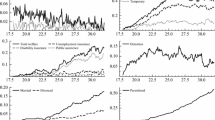Abstract
This article reports on a study which attempts to estimate the extent to which current and previous criminal activity reduces the employment of inner city black male youths from high poverty neighborhoods. The study finds a significant trade-off between employment and crime, with crime associated with a 10 to 12 percent reduction in employment of these youths. The policy implication is that increased criminal deterrence, as well as other programs, has a role to play in efforts to resolve the employment crisis for disadvantaged youths.
Similar content being viewed by others
Notes
My estimate is obtained by taking the number of blacks in jail or prison in 1981–82 and multiplying it by the approximate proportion in the age group less than 30. The number in jail in 1982 was 78,385; the number in prison in 1981 was 168,129, according to U.S. Department of Justice (1984), tables 6.17 and 6.24. On the basis of figures on age of sentenced inmates from U.S. Department of Justice,Profile of State Prison Inmates: Sociodemographic Findings from the 1974 Survey of Inmates of State Correctional Institutions, (Washington, D.C.: Department of Justice, 1980), table 35,I estimate that 75% of black inmates were less than 30 years of age. Data on arrests by age from U.S. Department of Justice,Sourcebook of Criminal Justice Statistics-1983, (Washington, D.C.: Bureau of Justice Statistics, 1984), table 4.4 show a comparable proportion. I divide the number by the population of black men ages 18 to 29 from U.S. Department of Commerce, Bureau of the Census,Statistical Abstract of the U.S.-1986 (Washington, D.C.: U.S. Government Printing Office, 1986), table 28: 2,998,000.
The specific figures are from the U.S. Bureau of the Census,Census of the Population-1980, U.S. Summary (PC80-D1-A) (Washington, D.C.: U.S. Government Printing Office, 1983), table 266. While not all institutionalized persons are in jail or prison, the vast majority are.
U.S. Department of Health, Education, and Welfare,Vital Statistics of the United States, 1977, volume B.
See Richard Freeman, “Crime and Unemployment” inCrime and Public Policy, James Q. Wilson (Ed.) (San Francisco: ICS Press, 1983), pp. 89–106.
Freeman, Richard and Harry Holzer,The Black Youth Joblessness Crisis (Chicago: University of Chicago Press, 1984). Chapter 1 describes the survey and summarizes results of the study.
W Kip. Viscusi, “Market Incentives for Criminal Behavior,” chapter 8 in Freeman and Holzer, pp. 301-346, and W. Kip Viscusi “The Risks and Rewards of Criminal Activity: A Comprehensive Test of Criminal Deterrence”Journal of Labor Economics Vol. 4, No. 3, part 1 (July 1986) 317-340.
M.H. Hindelang, T. Hirsch, and J. Wies,Measuring Delinquency (Beverly Hills, Calif.: Sage, 1981).
Approximately one-third of inmates in state prisons have no past sentence, implying a significantly larger group with criminal records than in jail at a point in time. See U.S. Department of Justice,Profile of State Prison Inmates: Sociodemographic Findings from the 1974 Survey of Inmates of State Correctional Institutions, Washington, 1974, table 32.
About this article
Cite this article
Freeman, R.B. The relation of criminal activity to black youth employment. Rev Black Polit Econ 16, 99–107 (1987). https://doi.org/10.1007/BF02900926
Issue Date:
DOI: https://doi.org/10.1007/BF02900926




